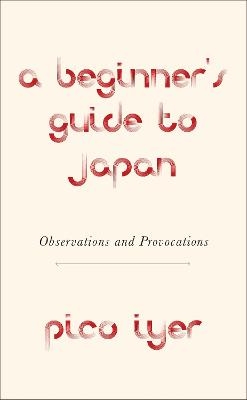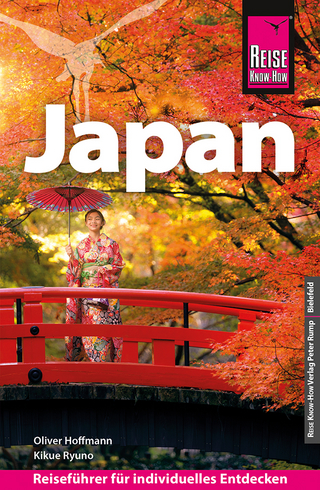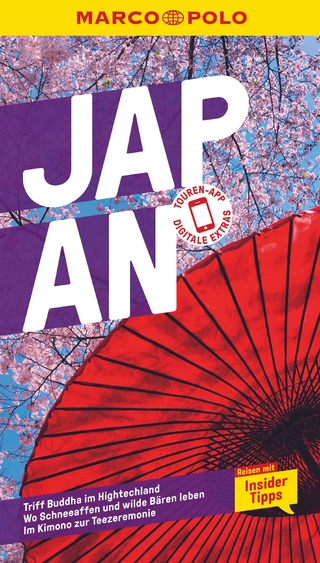
A Beginner's Guide to Japan
Alfred A. Knopf (Verlag)
978-1-5247-1173-3 (ISBN)
- Titel ist leider vergriffen;
keine Neuauflage - Artikel merken
The Enigmas of Arrival There are eleven arrows on the sign above you, as you disembark in Kyoto Station. They point left, right, straight ahead and backwards. In the middle is a question mark. - Platform 0 is close to Platforms 31 and 32, and a large "Restaurant Guide" board informs you that there are one hundred and seven dining options around the station alone. There are also twenty-two hotels in the immediate vicinity, just one of which offers fifteen banquet halls, five hundred and sixteen rooms, a halal menu, a clinic, a photo salon and a church. - So much is available, almost nothing can be found. You're in a living Web site of sorts-boxes and links popping up on every side, leading to art gallery and "Happy Terrace," to five-story post office and thirteen-floor department store-but nobody's given you the password. - There are snatches of English, French, German everywhere, but serving almost as decoration-like colors or sounds-and surrounded by characters in three non-overlapping alphabets. The net effect is of a hundred and one people speaking a thousand and two languages, none of which they understand. - There are no addresses, it's said, in Japan-or, worse, there are collections of numbers, but sometimes they refer to the chronology of construction, sometimes to something else. When my daughter, my wife, and I write down the address of the flat we've all shared, each one of us inscribes a completely different street name. - Before the West arrived, there were twice as many T-junctions and dead ends in Tokyo as there were thoroughfares. A castle town needs to confound invaders. After World War II, the city was reconstructed along the pathways that had come up around the rubble of bombed buildings, rendering the terrain even more impenetrable. - On the train into Kyoto, I point out to my Japanese wife a sweet ad full of teddy bears, one sporting a badge, another next to a bright-red ambulance. "Yes," she says. "It says that if you see a child who's been beaten, please call that number. If you do not, the child may die!" "And that picture of the cute fox and bear exchanging whispers?" "A lawyer," says Hiroko. "If you have some kind of accident, he can help." Dressing the Part I board the train on Saturday, and face a gaggle of schoolkids in uniform, lines of businessmen with badges on their lapels and squadrons of young women in dark suits. The next day I board the same train, to be greeted by a young guy in sockless canvas shoes and his date clomping along in high-fashion snowshoes (in a place where snow is almost unknown). Everyone's taken on a part, but in the off-hours, even close friends may be acting in different plays. - Hence couples on honeymoon in Japan traditionally wear matching outfits every hour of their trip. Even girls on a Sunday shopping spree often sport the same hairstyles, false eyelashes and white boots. Fashion becomes less about standing out than fitting in, at least within the micro-group of which you are a part. - After a rabbit appeared in Japan in 1873, the craze for the creatures grew so intense that a single animal fetched the equivalent of twenty thousand dollars. After a woman threw herself off the roof of a Tokyo apartment complex in 1970, roughly one hundred and fifty others threw themselves off the same roof. - For a foreigner, this means that clothes don't make the man here; they simply mark the role. But roles shift at the speed of light in Japan, as people adopt a radically different voice (even a different word for "I") for colleague and secretary and boss. If it's treacherous to judge a book by its cover, how much more so if it's a foreign book and has a dozen covers to go with every audience. - In 1999, I sought out the man said to have invented karaoke, to tell him that my editors at Time had chosen
| Erscheinungsdatum | 30.08.2019 |
|---|---|
| Verlagsort | New York |
| Sprache | englisch |
| Maße | 112 x 184 mm |
| Gewicht | 147 g |
| Themenwelt | Reisen ► Reiseberichte ► Asien |
| Reiseführer ► Asien ► Japan | |
| Geschichte ► Allgemeine Geschichte ► Zeitgeschichte | |
| Geisteswissenschaften ► Geschichte ► Regional- / Ländergeschichte | |
| Schlagworte | Asia • Asian Art • Beginners • books for dad • Books for men • Bucket List • gifts for history buffs • Historical books • History • history book • History books • history buff gifts • history gifts • History of Japan • Japan • japan book • japan books • Japanese • japanese cooking • Japanese culture • japanese gift • japanese gifts • Japanese history • Japanese language • Japanese mythology • japan history • Japan travel • Japan travel guide • Pico Iyer • Tourism • Travel • Travel book • travel books • travel gifts • World History • world history books |
| ISBN-10 | 1-5247-1173-X / 152471173X |
| ISBN-13 | 978-1-5247-1173-3 / 9781524711733 |
| Zustand | Neuware |
| Haben Sie eine Frage zum Produkt? |


